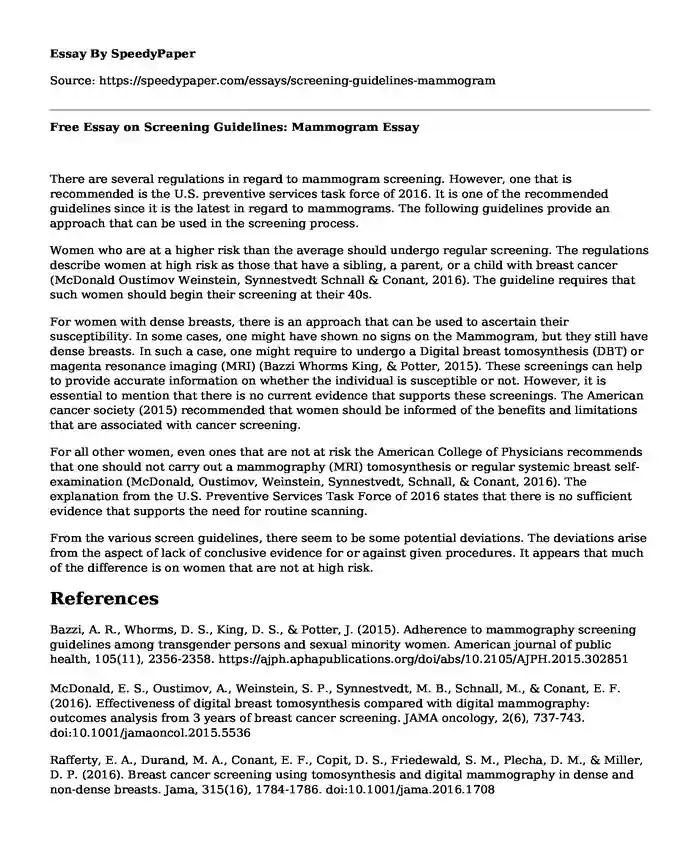
| Type of paper: | Research paper |
| Categories: | Women Cancer Healthcare policy Public health |
| Pages: | 2 |
| Wordcount: | 444 words |
There are several regulations in regard to mammogram screening. However, one that is recommended is the U.S. preventive services task force of 2016. It is one of the recommended guidelines since it is the latest in regard to mammograms. The following guidelines provide an approach that can be used in the screening process.
Women who are at a higher risk than the average should undergo regular screening. The regulations describe women at high risk as those that have a sibling, a parent, or a child with breast cancer (McDonald Oustimov Weinstein, Synnestvedt Schnall & Conant, 2016). The guideline requires that such women should begin their screening at their 40s.
For women with dense breasts, there is an approach that can be used to ascertain their susceptibility. In some cases, one might have shown no signs on the Mammogram, but they still have dense breasts. In such a case, one might require to undergo a Digital breast tomosynthesis (DBT) or magenta resonance imaging (MRI) (Bazzi Whorms King, & Potter, 2015). These screenings can help to provide accurate information on whether the individual is susceptible or not. However, it is essential to mention that there is no current evidence that supports these screenings. The American cancer society (2015) recommended that women should be informed of the benefits and limitations that are associated with cancer screening.
For all other women, even ones that are not at risk the American College of Physicians recommends that one should not carry out a mammography (MRI) tomosynthesis or regular systemic breast self-examination (McDonald, Oustimov, Weinstein, Synnestvedt, Schnall, & Conant, 2016). The explanation from the U.S. Preventive Services Task Force of 2016 states that there is no sufficient evidence that supports the need for routine scanning.
From the various screen guidelines, there seem to be some potential deviations. The deviations arise from the aspect of lack of conclusive evidence for or against given procedures. It appears that much of the difference is on women that are not at high risk.
References
Bazzi, A. R., Whorms, D. S., King, D. S., & Potter, J. (2015). Adherence to mammography screening guidelines among transgender persons and sexual minority women. American journal of public health, 105(11), 2356-2358. https://ajph.aphapublications.org/doi/abs/10.2105/AJPH.2015.302851
McDonald, E. S., Oustimov, A., Weinstein, S. P., Synnestvedt, M. B., Schnall, M., & Conant, E. F. (2016). Effectiveness of digital breast tomosynthesis compared with digital mammography: outcomes analysis from 3 years of breast cancer screening. JAMA oncology, 2(6), 737-743. doi:10.1001/jamaoncol.2015.5536
Rafferty, E. A., Durand, M. A., Conant, E. F., Copit, D. S., Friedewald, S. M., Plecha, D. M., & Miller, D. P. (2016). Breast cancer screening using tomosynthesis and digital mammography in dense and non-dense breasts. Jama, 315(16), 1784-1786. doi:10.1001/jama.2016.1708
Cite this page
Free Essay on Screening Guidelines: Mammogram. (2023, Feb 15). Retrieved from https://speedypaper.com/essays/screening-guidelines-mammogram
Request Removal
If you are the original author of this essay and no longer wish to have it published on the SpeedyPaper website, please click below to request its removal:
- How to Work Abroad Essay Samples
- What Is Nature and Nurture, Essay Sample
- Free Essay Sample: The Notion of Success in the American Society
- Essay Sample on How Having a Pet Benefits to Child
- Free Essay Sample about Child Sexual Abuse
- Business Essay Sample: Organizational Merger Plan
- Essay Example: Fecal Occult Blood Test
Popular categories




